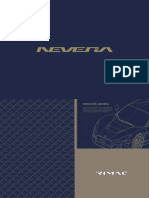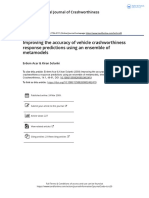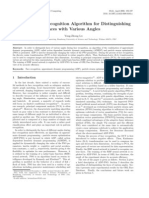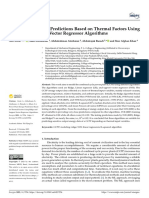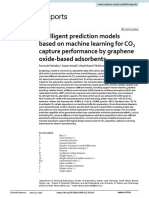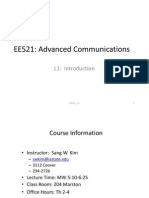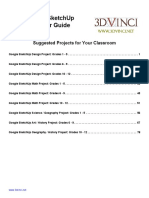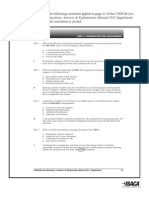Professional Documents
Culture Documents
Crisp 11
Crisp 11
Uploaded by
api-743431971Original Title
Copyright
Available Formats
Share this document
Did you find this document useful?
Is this content inappropriate?
Report this DocumentCopyright:
Available Formats
Crisp 11
Crisp 11
Uploaded by
api-743431971Copyright:
Available Formats
Optimization of Battery Management Systems Using
Artificial Intelligence
Iqra Mohammed Yakub, Syed Umer Ahmed, Shahd Darwish, Fahrettin Ay, Hasan Kurban
Electrical and Computer Engineering Program, Texas A&M University at Qatar, P.O. Box 23874, Doha, Qatar
ABSTRACT RESULTS
This research aimed to develop a Machine Learning (ML) To measure the goodness of fit, we used seventeen performance matrices namely, MAE (mean absolute error), RMSE (root mean
software capable of performing comprehensive regression squared error), and R-squared (coefficient of determination), etc, that are given as:
analysis through employing ensemble techniques combining σn yi )2 σn
1 n i=1(yi −ෝ i=0(yi −ෝyi )
multiple models and utilizing evaluation metrics to determine MAE = σ y − yො i , RMSE = , R2 = 1 −
n i=1 i n σni=0(yi −ഥ
y)
the most effective regression model for the given dataset. As a
case study, Electrochemical Impedance Spectroscopy (EIS)
measurements on Lithium-ion Batteries (LiBs) were used to
test the effectiveness of the software. To address this problem,
a software solution was developed through Python that
facilitates the analysis of diverse regression models and metrics
on the dataset. Our innovative approach, Comprehensive R-squared
Regression for Impedance Spectroscopy Prediction (CRISP),
leverages Artificial Intelligence (AI) to efficiently evaluate
numerous regression models across a wide range of metrics.
By focusing on enhancing EIS measurements, particularly in the
extra low frequency (ELF) region, CRISP demonstrates
MAE and RMSE Evaluation of each Regression Model
remarkable speed and accuracy, even under varying charging
states to predict real and imaginary parts of impedance
behavior Z, using a modest dataset. This pioneering software
holds significant promise for enabling online monitoring and
characterization of LiBs, thereby accelerating advancements in
LiBs technology.
INTRODUCTION
(LiBs) or lithium-ion batteries are assemblies of energy-dense
electrochemical devices (cells) whose size and effectiveness
has made their use omnipresent from simple sensors to
aircraft modules. EIS is an important technique for analytically
mapping out the characteristics and properties of LiBs. From
an electrochemical perspective, impedance can be described
as the collective opposition of the system to the flow of
electrical charges under AC excitations. Impedance Z can be
described as:
Heat Map Illustrating the Scaled Validation Score
Voting Regression Technique for Zr and Zj
This integrative, new study, combines the results of
experimental EIS measurements with a novel AI technique
called CRISP (Comprehensive Regression for Impedance
Spectroscopy Prediction) to regenerate the LiB impedance
including ELF range down to μHz region by letting a large Regenerated Nyquist Plot Visualization of the regression surface on empirical impedance data
pool of regression algorithms compete individually for
predicting both real Zr and imaginary parts Zj of Z. In this CONCLUSION & FUTURE WORKS
study the ML model is optimized by selecting the best fit In developing CRISP (Comprehensive Regression for Impedance Spectroscopy Prediction), we've successfully harnessed ensemble
function from a select possibilities to fit a given dataset. The techniques to model real-time events, specifically focusing on impedance, state of health, and charge dynamics in lithium-ion
optimization equation to find the best model for a given batteries (LiBs). Through our efforts, we have achieved our primary objective of significantly enhancing the prediction accuracy of
dataset is, F = {f |f : R → R} and a dataset ∆, determine f ∈ F, battery state of health, effectively reducing error rates typically ranging between 5-10% and hence extending the lifetime of
such that ∀g, g ∈ F → f ≤ g: LiBs. Leveraging Electrochemical Impedance Spectroscopy (EIS) data and our advanced software, we have created an application
that offers insightful analysis of battery health in real-time. Our accomplishment marks a significant step forward in revolutionizing
battery management practices, enabling the prolonged lifetimes and optimized performance of batteries across various
applications.
DESIGN AND IMPLEMENTATION NOTE The aim for the future is to deploy the CRISP application as a public web service that can be easily accessed online, along with
publishing the open-source code allowing for multiple renditions of the software. The ultimate objective is to deploy the most
Experiments were conducted to identify the most suitable pair refined version of the CRISP software onto Electric Vehicle (EV) batteries. By continuously enhancing and optimizing CRISP, we aim
of models that can fit the training data and generalize new data. to create a sophisticated battery management system tailored specifically for the unique requirements of EVs.
The protocol involved 33 regression models available in Scikit-
learn. One ensemble model was created based on the models ACKNOWLEDGEMNENT
with higher weights. The model's performance was evaluated We extend our sincere appreciation to Dr. Hasan Kurban for his outstanding leadership and invaluable guidance throughout this
using 17 different metrics, and a heat map was generated to research endeavour. Special thanks are due to Fahrettin Ay for his significant contributions to designing the machine learning
display the cross-validation scores of each model. The voting models, which greatly enhanced the depth and scope of our study. Additionally, we would like to acknowledge Dr. Selcuk Temiz for
regression model technique was used to select the top six his pivotal role in collecting the Electrochemical Impedance Spectroscopy (EIS) data, which formed the foundation of our research
models, and their weights were averaged to create an ensemble and allowed for a sophisticated testing dataset which CRISP could be executed on.
model. The data was initially split into training and testing sets.
Two experiments were conducted, one for predicting Zr and the REFERENCES
other for Zj. A machine learning software has been developed Grey, Clare P., and David S. Hall. “Prospects for Lithium-ion Batteries and Beyond—a 2030 Vision.” Nature Communications, vol. 11, no. 1, 8
to support comprehensive regression analysis on different Dec. 2020
datasets. This tool is set to be deployed soon, making it Gaberšček, Miran. “Understanding Li-based Battery Materials via Electrochemical Impedance Spectroscopy.” Nature Communications, vol.
accessible for everyone to use. 12, no. 1, 11 Nov. 2021
You might also like
- Patient Care Skills Patient Care Skills Minor 7th Edition Ebook PDFDocument61 pagesPatient Care Skills Patient Care Skills Minor 7th Edition Ebook PDFedith.beltran702100% (51)
- Nevera Brochure DigitalDocument43 pagesNevera Brochure DigitalLe_YorlNo ratings yet
- 108 SubmissionDocument6 pages108 SubmissionSpruha JNo ratings yet
- 2014-Medical Image Fusion Based On Joint Sparse MethodDocument4 pages2014-Medical Image Fusion Based On Joint Sparse Methodpraveenkumar smNo ratings yet
- 10 1002@qua 26035Document7 pages10 1002@qua 26035shahriyar20002No ratings yet
- Improving The Accuracy of Vehicle Crashworthiness Response Predictions Using An Ensemble of MetamodelsDocument14 pagesImproving The Accuracy of Vehicle Crashworthiness Response Predictions Using An Ensemble of MetamodelsSairam PeddiNo ratings yet
- Electric Power Systems Research: SciencedirectDocument7 pagesElectric Power Systems Research: SciencedirectImanTaheriNo ratings yet
- What Is The Appropriate Data Representation of Electrochemical Impedance Spectroscopy in Machine Learning AnalysisDocument20 pagesWhat Is The Appropriate Data Representation of Electrochemical Impedance Spectroscopy in Machine Learning AnalysisMert GüngörNo ratings yet
- Enhanced Face Recognition Algorithm Using PCA With Artificial Neural NetworksDocument9 pagesEnhanced Face Recognition Algorithm Using PCA With Artificial Neural Networksnedal altitiNo ratings yet
- A Novel Face Recognition Algorithm For Distinguishing Faces With Various AnglesDocument5 pagesA Novel Face Recognition Algorithm For Distinguishing Faces With Various Anglestjvg1991No ratings yet
- Development OfpointkernelDocument13 pagesDevelopment Ofpointkernelbilguun_byambadorjNo ratings yet
- Paper 6 SummaryDocument6 pagesPaper 6 Summaryshindesarvesh70No ratings yet
- Adityo 2020 J. Phys. Conf. Ser. 1511 012074Document11 pagesAdityo 2020 J. Phys. Conf. Ser. 1511 012074HendratoNo ratings yet
- Manisha Satone 2014Document14 pagesManisha Satone 2014Neeraj KannaugiyaNo ratings yet
- Gomez CR-MetaHeuristicsDocument17 pagesGomez CR-MetaHeuristicsValse83No ratings yet
- Evolutionary Programming Optimization Technique FoDocument7 pagesEvolutionary Programming Optimization Technique FoJean Baptiste nkongoloNo ratings yet
- 1 s2.0 S2352484721014487 MainDocument16 pages1 s2.0 S2352484721014487 Mainnsikakabasi OkonNo ratings yet
- (2020-TII) Evolving Deep Echo State Networks For Intelligent Fault DiagnosisDocument10 pages(2020-TII) Evolving Deep Echo State Networks For Intelligent Fault DiagnosisallenwuwangNo ratings yet
- A Combination of Newton-Raphson Method and HeuristDocument14 pagesA Combination of Newton-Raphson Method and Heuristpat juvNo ratings yet
- All OptimizersDocument13 pagesAll Optimizersnada montasser gaberNo ratings yet
- Weller 14 AlwDocument11 pagesWeller 14 Alwsuper_montyNo ratings yet
- Artificial Neural Network Based Energy Storage System Modeling For Hybrid Electric VehiclesDocument24 pagesArtificial Neural Network Based Energy Storage System Modeling For Hybrid Electric VehiclessathyaNo ratings yet
- 1 s2.0 S2667305323000273 MainDocument18 pages1 s2.0 S2667305323000273 MainSumeet MitraNo ratings yet
- Energies 14 07254 CompressedDocument22 pagesEnergies 14 07254 CompressedSAAD AL.SHAHRANINo ratings yet
- LiBEIS A Software Tool For Broadband Electrochemical ImpedanceDocument4 pagesLiBEIS A Software Tool For Broadband Electrochemical Impedancelukasz15432No ratings yet
- ALSRAC Approximate Logic Synthesis by Resubstitution With Approximate Care SetDocument6 pagesALSRAC Approximate Logic Synthesis by Resubstitution With Approximate Care Set張哲銘No ratings yet
- Super ResolutionDocument13 pagesSuper Resolutionm.hajihosseini95No ratings yet
- Hydro 2009 017Document12 pagesHydro 2009 017Dr. Akshay ChaudharyNo ratings yet
- Analysis in Time Series Model For RGUKT, R.K. Valley Campus HT Feeder Load Forecasting Using Linear RegressionDocument2 pagesAnalysis in Time Series Model For RGUKT, R.K. Valley Campus HT Feeder Load Forecasting Using Linear RegressionAbhishek MishraNo ratings yet
- Performance Analysis of Solar PV ParameterDocument15 pagesPerformance Analysis of Solar PV ParametersriNo ratings yet
- One Millisecond Face Alignment With An Ensemble of Regression TreesDocument8 pagesOne Millisecond Face Alignment With An Ensemble of Regression TreesJeffersonNo ratings yet
- Utilization of Multilayer Perceptron For Determining The Inverse Kinematics of An Industrial Robotic ManipulatorDocument11 pagesUtilization of Multilayer Perceptron For Determining The Inverse Kinematics of An Industrial Robotic Manipulatorgovind raoNo ratings yet
- Low Multi-Modal Aerial View Image Challenge Translation From Synthetic Aperture Radar CVPRW 2023 PaperDocument9 pagesLow Multi-Modal Aerial View Image Challenge Translation From Synthetic Aperture Radar CVPRW 2023 PaperSıla KazanNo ratings yet
- State Estimation Distributed Processing: Reza Ebrahimian and Ross BaldickDocument7 pagesState Estimation Distributed Processing: Reza Ebrahimian and Ross BaldickalimaghamiNo ratings yet
- 2018 A Comparative Study of Different Curve Fitting Algorithms in ANNDocument5 pages2018 A Comparative Study of Different Curve Fitting Algorithms in ANNEhtesham AshrafNo ratings yet
- Applied Radiation and Isotopes: H. Ishizu, T. YamadaDocument4 pagesApplied Radiation and Isotopes: H. Ishizu, T. YamadaabcNo ratings yet
- A Review On Optimization of Least Square PDFDocument15 pagesA Review On Optimization of Least Square PDFSam SorenNo ratings yet
- Comparison of Algorithms For Segmentation of Blood Vessels in Fundus ImagesDocument5 pagesComparison of Algorithms For Segmentation of Blood Vessels in Fundus Imagesyt HehkkeNo ratings yet
- Machine LearningDocument13 pagesMachine Learningpavan gangwarNo ratings yet
- Renewable and Sustainable Energy Reviews: Amandeep Sharma, Ajay KakkarDocument16 pagesRenewable and Sustainable Energy Reviews: Amandeep Sharma, Ajay KakkarNadja GomesNo ratings yet
- An Efficient Surrogate Assisted Particle Swarm Optimization For Antenna SynthesisDocument8 pagesAn Efficient Surrogate Assisted Particle Swarm Optimization For Antenna Synthesishelio_1972No ratings yet
- An Unsupervised Learning Model For Deformable Medical Image RegistrationDocument9 pagesAn Unsupervised Learning Model For Deformable Medical Image RegistrationShuai ZhangNo ratings yet
- Rotate Vector Reducer Fault Diagnosis Model Based PDFDocument17 pagesRotate Vector Reducer Fault Diagnosis Model Based PDFAishwaryaNo ratings yet
- Health Prognosis With Optimized Feature Selection For Lithium-Ion Battery in Electric Vehicle ApplicationsDocument10 pagesHealth Prognosis With Optimized Feature Selection For Lithium-Ion Battery in Electric Vehicle Applicationshmp8558No ratings yet
- ICSCSP 2021 Proceedings-477-488Document12 pagesICSCSP 2021 Proceedings-477-488R.V.S.LALITHANo ratings yet
- Single Image Super Resolution Using Interpolation and Discrete Wavelet TransformDocument9 pagesSingle Image Super Resolution Using Interpolation and Discrete Wavelet TransformEditor IJTSRDNo ratings yet
- Performance Analysis of Linear Appearance Based Algorithms For Face RecognitionDocument10 pagesPerformance Analysis of Linear Appearance Based Algorithms For Face Recognitionsurendiran123No ratings yet
- Electric Load Forecasting by The SVR Model With Differential Empirical Mode Decomposition and Auto RegressionDocument13 pagesElectric Load Forecasting by The SVR Model With Differential Empirical Mode Decomposition and Auto RegressionGneves23No ratings yet
- Adaptive Relevance Vector Machine Combined With Markov-Chain-Based Importance Sampling For Reliability AnalysisDocument11 pagesAdaptive Relevance Vector Machine Combined With Markov-Chain-Based Importance Sampling For Reliability AnalysisBenjaa CaviedesNo ratings yet
- Quantitative Comparison of Linear and Non-Linear Dimensionality Reduction Techniques For Solar Image ArchivesDocument6 pagesQuantitative Comparison of Linear and Non-Linear Dimensionality Reduction Techniques For Solar Image ArchivesOmega AlphaNo ratings yet
- Closing The Data Gap Between Simulation and Modal Test With Virtualized Testing For An Improved FE Model UpdateDocument13 pagesClosing The Data Gap Between Simulation and Modal Test With Virtualized Testing For An Improved FE Model UpdatevinoesakkiNo ratings yet
- An Inter-Comparison of Three Spectral-DeconvolutioDocument9 pagesAn Inter-Comparison of Three Spectral-DeconvolutiojaloaliniskiNo ratings yet
- Face Feature Extraction For Recognition Using Radon TransformDocument6 pagesFace Feature Extraction For Recognition Using Radon TransformAJER JOURNALNo ratings yet
- House Price Prediction Using Regression Techniques: A Comparative StudyDocument5 pagesHouse Price Prediction Using Regression Techniques: A Comparative StudyAparna KambleNo ratings yet
- Intelligent Prediction Models Based On Machine Learning For CO Capture Performance by Graphene Oxide Based AdsorbentsDocument20 pagesIntelligent Prediction Models Based On Machine Learning For CO Capture Performance by Graphene Oxide Based AdsorbentsarashNo ratings yet
- Stereo Matching PHD ThesisDocument5 pagesStereo Matching PHD Thesisykramhiig100% (2)
- A Deep Learning Framework For Solution and Discovery in Solid MechanicsDocument24 pagesA Deep Learning Framework For Solution and Discovery in Solid MechanicseliwzNo ratings yet
- A Novel Interpretable Ensemble Learning Method For NIR-Based Rapid Characterization of Petroleum Products-1Document11 pagesA Novel Interpretable Ensemble Learning Method For NIR-Based Rapid Characterization of Petroleum Products-1Phan NhậtNo ratings yet
- Application of Artificial Neural Networks For Response 2012 Journal of AdvaDocument11 pagesApplication of Artificial Neural Networks For Response 2012 Journal of AdvanazrulharizNo ratings yet
- 7 A SVM Based Method For Face Recognition Using A Wavelet PCADocument4 pages7 A SVM Based Method For Face Recognition Using A Wavelet PCAvenkata rao RampayNo ratings yet
- MapDocument5 pagesMapMarc AsenjoNo ratings yet
- Design and Implementation of Portable Impedance AnalyzersFrom EverandDesign and Implementation of Portable Impedance AnalyzersNo ratings yet
- Sika Floor Coating ProceduresDocument3 pagesSika Floor Coating Proceduresmuhamadrafie1975No ratings yet
- Isar (V3 Flue System) Your Ideal Installation and Servicing GuideDocument68 pagesIsar (V3 Flue System) Your Ideal Installation and Servicing GuideasturphateNo ratings yet
- EE521: Advanced Communications EE521: Advanced CommunicationsDocument25 pagesEE521: Advanced Communications EE521: Advanced CommunicationsTa HienNo ratings yet
- Google Sketchup Teacher Guide PDFDocument89 pagesGoogle Sketchup Teacher Guide PDFNuno100% (1)
- United States v. Sterlyn Hewlett, 4th Cir. (2014)Document3 pagesUnited States v. Sterlyn Hewlett, 4th Cir. (2014)Scribd Government DocsNo ratings yet
- Logistics ManagementDocument3 pagesLogistics ManagementRüel DellovaNo ratings yet
- CPS - Data Intensive Distributed ComputingDocument11 pagesCPS - Data Intensive Distributed ComputingManoj KavediaNo ratings yet
- GEP 12A F4 Manual EN V1 - 4Document1 pageGEP 12A F4 Manual EN V1 - 4KSU WIRADARMANo ratings yet
- HPro U 17 18 Course CatalogDocument46 pagesHPro U 17 18 Course Catalogsuman kumarNo ratings yet
- Surface Roughness Measurement FINALDocument8 pagesSurface Roughness Measurement FINALVishweshRaviShrimaliNo ratings yet
- CISM QAE Sup Correction1 24 2010Document4 pagesCISM QAE Sup Correction1 24 2010Mstar Church100% (1)
- LECTURE - 6: Ethylene Derivatives: Ethylene Oxide and Ethanol Amines 6.1 Ethylene OxideDocument7 pagesLECTURE - 6: Ethylene Derivatives: Ethylene Oxide and Ethanol Amines 6.1 Ethylene Oxideمحمود محمدNo ratings yet
- Master Emaco S5400Document2 pagesMaster Emaco S5400WahyudiBlueghostNo ratings yet
- ALFM Peso Bond Fund Inc. - 202205 1Document2 pagesALFM Peso Bond Fund Inc. - 202205 1C KNo ratings yet
- ASTM A424 Enameling PDFDocument3 pagesASTM A424 Enameling PDFhdierkeNo ratings yet
- First Phase: Collaborative Project Adfu-Aemd English IiiDocument7 pagesFirst Phase: Collaborative Project Adfu-Aemd English Iiilina suarezNo ratings yet
- U11Document32 pagesU11Kapildev KumarNo ratings yet
- Proud To Be VeganDocument2 pagesProud To Be VeganVegan FutureNo ratings yet
- Organizational Behavior in SportDocument26 pagesOrganizational Behavior in SportfjrvlogsNo ratings yet
- An Approach of Voltage Stability Analysis For IEEE 9 Bus System With UPFCDocument12 pagesAn Approach of Voltage Stability Analysis For IEEE 9 Bus System With UPFCDrMohammad Rafee ShaikNo ratings yet
- Для Просмотра Статьи Разгадайте КапчуDocument7 pagesДля Просмотра Статьи Разгадайте КапчуYoucef IslemNo ratings yet
- HeroMotoCorp Is Now WorldDocument2 pagesHeroMotoCorp Is Now Worldp.sankaranarayananNo ratings yet
- Business Individual Activity Ent300Document14 pagesBusiness Individual Activity Ent300Muhammad Khairul Akmal Bin MazlanNo ratings yet
- Invoice 18-19..Document1,034 pagesInvoice 18-19..jpkassociates2019No ratings yet
- Sampath Yadav Gaddam: Career ObjectiveDocument2 pagesSampath Yadav Gaddam: Career Objectivesampath yadavNo ratings yet
- Facilitate Learning SessionDocument8 pagesFacilitate Learning SessionJoviner Yabres LactamNo ratings yet
- Manual Swift Cam 300Document23 pagesManual Swift Cam 300Gonzalo GNNo ratings yet
- Marketing Plan - Heineken BrazilDocument9 pagesMarketing Plan - Heineken BrazilMaria Cristina Tavares Lacerda Mansur PaixãoNo ratings yet

